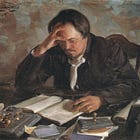I answered truthfully with what is still an entirely correct non-answer.
I can do better. There is one ingredient that I believe universally heightens all fiction.
But first, let’s take care of some business—in 3 parts:
1. Easily Manage Your Subscription
Every Section has a toggle. Toggle on the ones you want to receive and toggle off the ones you don't.
This is part of The Re:Write Series.
To choose which series come to your inbox, go to:
https://literarysalon.thaddeusthomas.com/account
2.a. Paid subscribers—Open Word deadline.
I’ve presented a proposed deadline for the first flash stories. Check the Open World channel in our forum. I’ll send out general news on the agreed upon deadline shortly.
2.b. I’m giving away paperback books
To the first ten people who join our reading group in the forum, and the forum is available to paid subscribers, only.
3. Not yet subscribed to Literary Salon?
Check out the deep discount you can keep forever:
Now, let’s discuss: The Secret Sauce.
There is a primacy that must be mentioned even before I broach today’s topic. I had a couple of friends comments “Bars!” on different statements of mine yesterday, and I had to ask what it meant. After the fact, I remembered hearing rappers discuss music this way, but I was at a loss until a couple of people came to my rescue.
It basically means that every line has impact. It’s a consistent, unrelenting display of quality, and this—even more than the secret sauce—is the answer to the question I should have given. The nature of that quality will vary, as I said in my response, but what defines a great work of fiction is a higher concentration of delivered goods.
To have the greatest impact on the reader, the writer and the reader must be in agreement on what qualities are desirable, and in these qualities the writer must deliver with greater frequency and potency than his peers.
That is the singular truth of greatness.
But it says nothing of what those qualities are because those qualities change with time, taste, and genre. Today, I want to talk about one that has caught my attention in recent months and which comes as close as anything I can think of to being that universal quality that will heighten any story.
Discover all my essays on:
Contrast
If you want to elicit sorrow in a reader, give them joy as well. Spend the same number of words compounding woes, and it quickly means nothing. The emotional nerves grow numb, and even worse—oh, the horror!—the reader gets bored. Instead of weeping they’re yawning and scanning ahead, looking for change. Give them joy, and they have a reason to care and to weep with sorrow, to cringe with fear, and to shriek with terror.
One of the distinct qualities of Cormac McCarthy’s writing is how the voice of the narrative will starkly contrast with the voice of his characters. Character voices will be distinct as well, contrasting with one another.
A character’s actions in one context will contrast with his actions in another. Sentence type and length need contrast (variation) to engage the mind. One setting contrasts with another; one personality with another. The actions of the characters in one scene contrast with the actions in the next, avoiding everything settling into a murky mud of sameness.
Contrast heightens the flavor of every other quality in your writing, and without it, the mind grows weary and the writing, dull.
The Book Salon Free Book Promotion (4/19 - 5/17)
Consistency through Change
Reveal the contrasting aspects of character early. Let these aspects hold self-contradicting goals that result in a dilemma that must be resolved. Let both goals be good, desirable, or necessary, and the reader will feel that inner conflict, knowing instinctively that some good will have to be sacrificed. The resulting character will feel real and whole and will act in contrasting ways that maintain a reader’s interest while being consistently in character.
Contrast in Scene Types
A scene can focus on conversation. It can be outward action or internal thought. Often it will be a combination of these factors, but each scene has its focus, and those foci are another source of contrast.
In reality, though, most of us are confused about what makes up a scene. We have this concept from movie scripts that scenes change with location, and that’s not true, not even in the script—although many executive-types don’t understand this point. A scene can stretch across locations. A single location with a single continuous action between the same characters can contain multiple scenes.
I know. I lost a few of you. Something new has to be introduced, right? If not a new location, then a new character, at least—right? When you Google the question, that’s the answer you get. Google has to be right!
A scene has a cohesive focus. Character can come and go and we can cross several locations, but as long as the cohesive focus remains, it’s the same scene. We can be in a single room with the same three characters who never leave, but when the cohesive focus shifts to something else, we have a new scene.
Don’t like it? That’s okay. Call it something else. Call it units of cohesive focus.
As the writer moves from one unit of cohesive focus (UCF) to the next, one goal is to reengage the reader’s mind. We make a mistake in believing that’s only done with the next big thing. Consider every UCF as an opportunity for greatness, especially when the stakes are small and the actions mundane.
Spotlight the focus. Give it a thematic cohesion for the length of the UCF, and do so creatively wherever possible. Bold colors make for high contrast.
There’s a scene from Such was the Epiphany of Theodore Beasley that sticks out as my attempt to apply all this. It’s a small scene and nothing anyone would likely comment on, but I attempted a few techniques to keep the reader engaged. The story to this point had been narrative with one section of mostly indirect dialogue. The story now moves into this little scene featuring Elizabeth and the marriage therapist:
Elizabeth waited. Their therapist waited.
“He said he’d be here,” Elizabeth said. “He said he was buying a gun, but he said he’d be here.”
“Theodore’s buying a gun?”
“That’s what he said.”
“Is this something the two of you discussed?”
“It’s the first I’ve heard him say.”
“So you don’t know why he wants a gun?”
“Well, I don’t know. Last night, he was saying he’d protect me.”
“Do you need protecting?”
“It doesn’t matter. I said that to him. I said, it doesn’t matter.”
“Why doesn’t it matter?”
“Because he’s all talk and always has been. He said he’d be here.”
When Elizabeth leaves, that’s a shift of focus. This conversation is the entire scene, and it’s all conversation—a contrast with what’s come before. I attempted to give the scene a thematic unity by playing with the dialogue. The therapist is almost entirely reflecting back what Elizabeth has said, rephrasing it as a question and keeping the focus on her, and Elizabeth’s side of the conversation focuses on a repetition of the word said. The trouble in the marriage is conveyed within the confines of this repetition, culminating in the statement that Theodore is all talk.
And this is done with conversation about the purchase of the gun, which is our clue as to where we are in the story’s timeline.
— Thaddeus Thomas
Weekly Flash Fiction for Paid Subscribers—these won’t be emailed to you, but you’ll find the link in my regular posts. Here’s a fantasy flash fiction story for you:







Ah you’re speaking my language here - this feels a lot like Stanislavsky - Units and Beats - Units build scenes beats build units - all are driven by the internal motivations of the characters which may change at every beat/unit/scene or may remain constant throughout an entire play - the colour/ contrast comes from the character playing with different tactics to try to satisfy their wants and fulfill their motivations- everyone and everything (very important note - the location/ time of day: costumes and props all have a role) is either working for or working against everyone else - when you dissect a script in this way the individual fibres that make up the whole become visible and you get to weave them back together for your audience - it’s really hard to do consciously when writing but extremely powerful when editing (for me) to consider each Character in this way - it’s how I was trained as a theatre director- I really didn’t get it at the time.